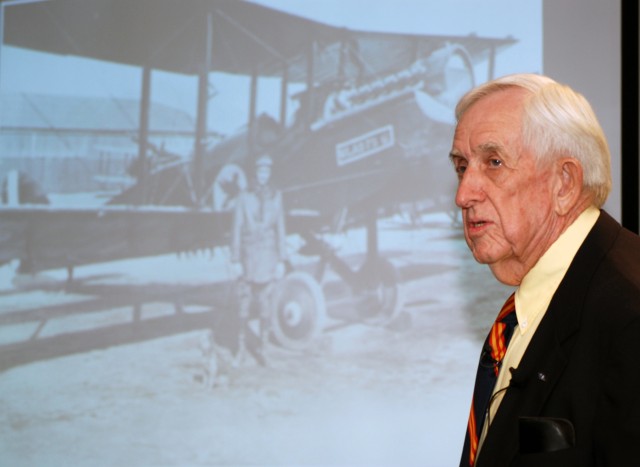The Army and Fort Bliss' influence on El Paso history and development can be seen in the Aviation History Gallery, which opened Friday in the El Paso International Airport.
"An organization that doesn't have a history doesn't have a future," said Patrick T. Abeln, the El Paso International Airport director of aviation. "In the early days there was not a lot of separation between military and civilian flights. With the existence of Biggs, we had military aviation in the area long before civilian aviation."
The gallery features historical photographs and artifacts documenting the creation and expansion of flight in El Paso.
John Paul Jones, an aviation artist and historian, highlighted the influence of Fort Bliss and Biggs Army Airfield in attracting and diversifying local aviation as part of the airport's 80th anniversary lecture series.
Jones said the early Army planes were all experimental, and that "everything [pilots] did in the '20s and '30s was a record-setting attempt - a speed record, an altitude record or a distance record."
The lectures, photographs and exhibits cover the history of the Fort Bliss Flying Field, which existed from 1919 to 1926, and the creation of Biggs Army Airfield in 1926, which was named after a local World War I Soldier.
The first aircraft assigned to Fort Bliss was the C-1 Balloon. Unfortunately, the aircraft hangar's door faced north, thus making the removal of the balloon from the hangar very risky and hazardous with the western winds whipping off the mountains.
One photograph from 1919 depicts how spectators at early-era air shows were dropped off at the Cassidy Gate via a trolley and had to walk the entire length of the post to the flight line between Biggs and the current airport.
"In the old days they even had to caution the cavalry Soldiers not to wear their spurs while getting into a fabric airplane," Jones said.
The El Paso International Airport regularly recognizes and honors the influence of Soldiers, the Army and Fort Bliss in the local historical and current aviation environments. They recently added signs directing the thousands of traveling Soldiers to the airport's Military Help Desk, and a new banner promoting Fort Bliss greets departing and arriving passengers in the terminal.
"In World War II, Korea and even today, we have serviced a lot of military aircraft," said Abeln. "It's a strong partnership. Soldiers, Fort Bliss and Biggs have been a huge asset to us, and I'd like to think we help them out too."
###


Social Sharing